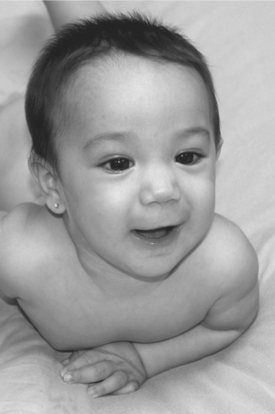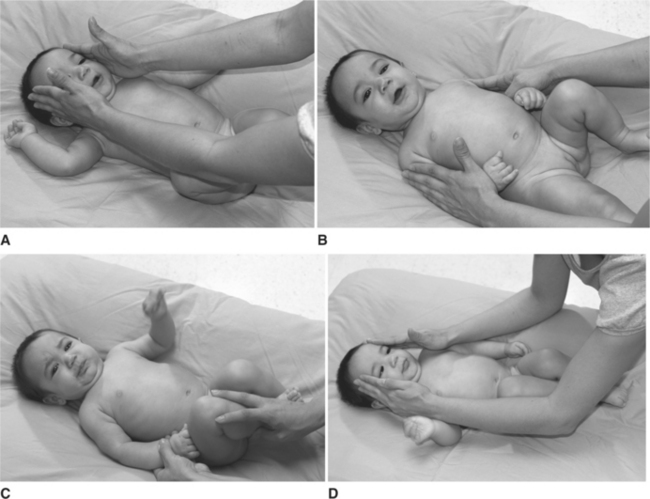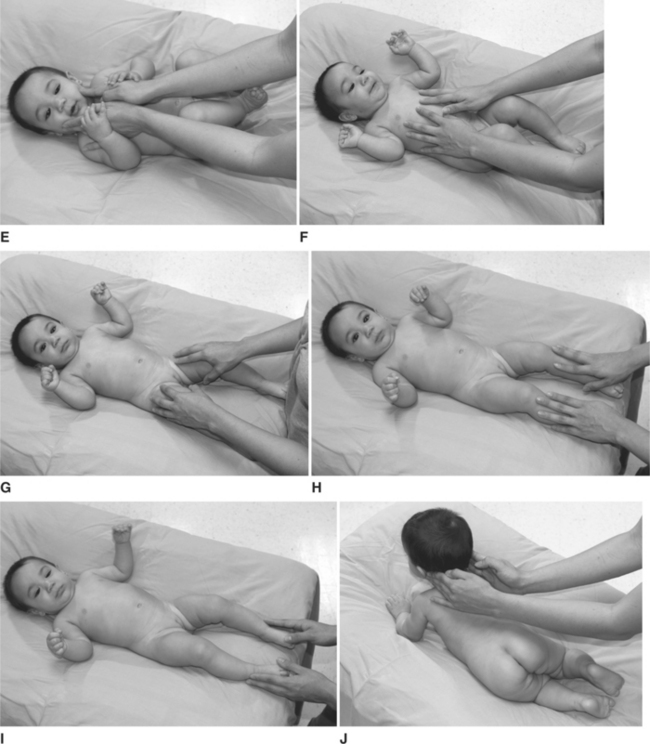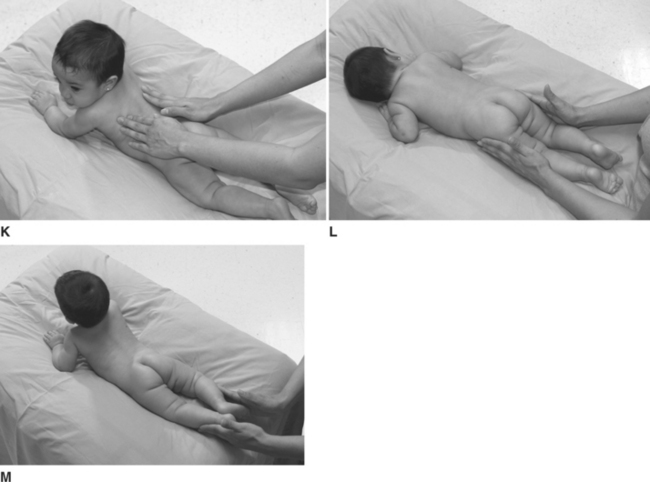Chapter 14 Massage for the Baby and Infant
The use of various forms of soft tissue manipulation (massage) for babies and infants has been described and promoted for many centuries and in some Eastern cultures (India and China) for millennia. The use of various forms of tactile stimulation is therefore a time-honored method of promoting relaxation, contentment and normal development in babies and infants. Rocking the baby, gently rubbing the head, stroking the hands and feet, and simply touching the baby’s skin are examples common to many cultures.
Massage is beneficial for all babies and infants, regardless of whether they have problems. In terms of an age differential between babies and infants for massage, a baby is usually considered to be a child less than 3 months old and an infant is 3 to 12 months of age. Obviously, the major difference between the use of massage in these two groups is that the younger the baby, the greater the care required (especially much less pressure). Benefits to both parents and baby include pleasure, confidence, communication, relaxation, reassurance through skin contact, development of body awareness, and calmness (Adamson, 1996; Agarwal et al., 2000; Booth et al., 1985; Debelle, 1981; Field, 1995, 1999; Ireland, 2000; Lindrea & Stainton, 2000; Mainous, 2002; McClure, 1989, 2000; Ottenbacher et al., 1987; Reid, 2000; Wall, 1998; Watson, 1999). In addition, infant massage may also be of value in improving the mother-infant interaction for mothers with postnatal depression, thereby avoiding the many problems that can result for both mother and child (Onozawa, 2001) (Box 14-1).
BOX 14-1 Situations That Suggest the Benefits of Massage for a Baby or Infant
Infants who undergo surgery can be included in this category, as can the preterm baby. These babies need to learn that touch can be pleasurable because some of their early experiences (such as monitoring devices, various life support, and other invasive procedures) have been painful or uncomfortable. A variety of studies provide evidence of the benefits of massage for the preterm infant, such as improved weight gain, fewer facial grimaces, less fist clenching, and enhanced development of the sympathetic nervous system (Browne, 2000; Dieter et al., 2003; Feldman, 1998; Field et al., 1986, 1987; Kuhn et al., 1991; Ottenbacher et al., 1987; Rice, 1975; Scafidi et al., 1993; Solkoff et al., 1975; White-Traut & Goldman, 1988; White-Traut & Pate, 1987). Although many studies report beneficial effects of massage in the preterm infant, there are significant methodological issues that still need to be resolved (Vickers et al., 2000). In contrast, babies who are not particularly active can be stimulated, rather than relaxed, with massage techniques that alternate light tickling with gentle, firm pressure.
Massage has effects on babies and infants similar to those on adults, and it is not surprising that it can be helpful for a number of conditions, such as asthma (Field, 1998), colic (Huhtala et al., 2000; Larson, 1990), and infantile congenital myogenic torticollis (Xu, 1992). Although massage is beneficial, it is not without risk, and a few studies have explored issues that might be a problem, especially for the baby or infant (Joyce, 1996; White-Traut & Goldman, 1988).
Further reading can be found in a number of texts that address various aspects of the many benefits and techniques of baby or infant massage (Auckett, 1982; Drehobl, 2000; Fan, 1999; Gordon & Adderly, 1999; Heinl, 1991; Leboyer, 1976a, 1976b; McClure, 1989; Prudence, 1984; Schneider, 1982; Tiquia, 1986; Walker, 1996).
TECHNIQUE FOR BABY OR INFANT MASSAGE
Preparations for massage of a baby or infant include attention to all of the factors listed previously (see Chapter 3), with special attention paid to creating a peaceful atmosphere (no phones or loud noises, etc.). Soothing music may be beneficial, as well as subdued lighting, appropriate room temperature (no drafts), and the use of a natural massage oil (e.g., almond, olive, or apricot). A small amount of baby powder can be used as an alternative, being careful not to pepper the baby with powder as this may create a problem if the powder is inhaled. Although massage may be given at almost any time of the day or night, it will probably be most effective when both parent and baby are relaxed and the baby is not hungry. A suitable time might be immediately following a warm bath. Parts of the baby or infant not being massaged may be covered with a light blanket or towel if necessary to maintain body temperature. Maintaining a proper body temperature is important because the baby’s entire skin surface may be exposed during massage.
GENERAL WHOLE-BODY STROKING
The baby or infant is comfortably positioned in supine lying. Gentle stroking begins at the side of the head and passes down each upper limb to the hands. A second stroke begins again at the side of the head, this time passing down the chest and abdomen and along each lower limb to the feet. Each stroke is slow and gentle, and the entire sequence of movements can be repeated at least six times. The posterior aspect of the baby or infant can also be massaged in a similar manner. This time, the baby or infant is positioned in prone lying with the head comfortably turned to one side. The first stroke begins at each shoulder girdle region, and the therapist’s hands pass out and along the arms to the hands. The therapist then lifts his or her hands off the baby, and the second stroke begins again at the shoulder girdle. This time, the therapist’s hands move down the baby’s back, over the buttocks, and along the lower limbs to the foot. The entire sequence of strokes is then repeated at least six times. A single- or two-handed technique can be used, as seems appropriate. When a two-handed technique is used, the therapist’s hands may be used in a simultaneous or alternate fashion. Figure 14-1 illustrates these techniques.












